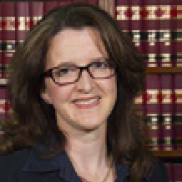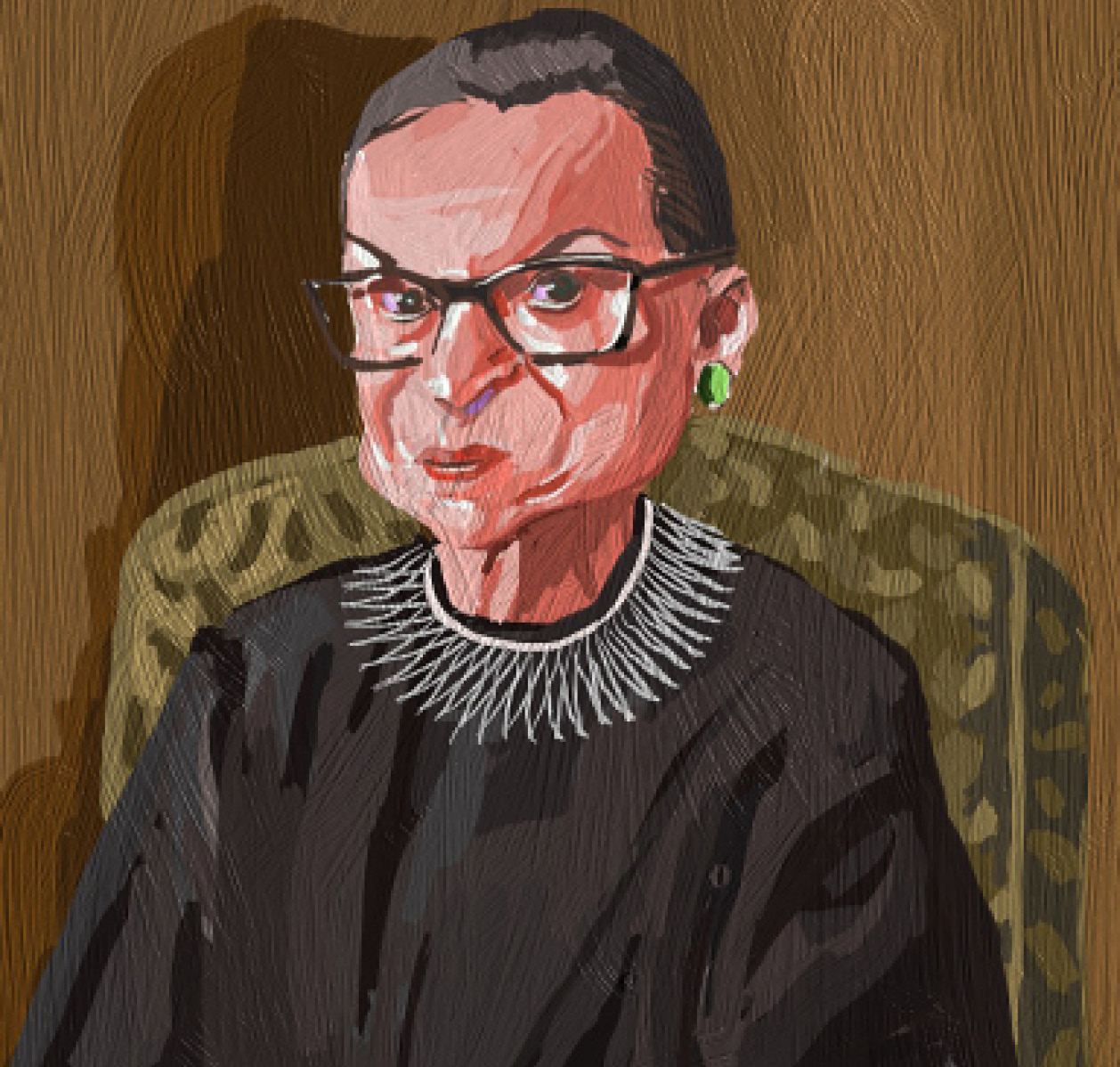Justice Ruth Bader Ginsburg: the Vägmärken (waypaver)

In June 1946, thirteen year old Ruth Bader Ginsburg wrote a column for her school newspaper. Mixed with pieces on a school play and a circus, Ruth from Grade 8B1 wrote about four great documents known to the world since the beginning of time, “great because of all the benefits to humanity which came about as a result of their fine ideals and principles”.1 She urged children of public school age to aid the promotion of peace because “now we have a fifth great document”, the Charter of the United Nations.2
Such a profound early understanding of powers and principles for stable, peaceful and democratic government, and appreciation of the importance of tolerance and neighbourhood – Justice Ruth Bader Ginsburg was destined to leave a great legacy as a determined advocate for equality and principled jurist.
Less foreseeable, however, was Justice Ginsburg’s elevation to icon in popular culture as an octogenarian, dubbed as 'Notorious RBG' (after the rapper Notorious BIG), or that her dissents and popular standing would inspire books, songs and merchandise. In recent years she even featured in a comic opera, Scalia/Ginsburg, which includes a duet titled We Are Different, We Are One – reflecting the Justices’ difference on questions of major import, but unity in their reverence for the institution of the Supreme Court and in their collegiality.

Rocco Fazzari
Justice Ginsburg was also famous in her determination to stay physically fit and strong. Her hour-long workout routine during her later life added a dimension to her prominence when it was published in an exercise book The RBG Workout… How She Stays Strong… and You Can Too! From planks to squats to push-ups – the book is illustrated with Justice Ginsburg in her workout gear and embellished with 'tips from the bench'.
But her deeper legacy remains her lifelong determination to oversee changes to law and public conscience by jurisprudence in gender equality. In Swedish – Justice Ginsburg practised in Sweden as a young lawyer in the 1950s – an apt concept is captured by the word 'vägmärken', translating literally as 'pathmarker' or 'waypaver'.
Despite her commitment since childhood to ideals and equality, Justice Ginsburg’s appointment to the US Supreme Court in 1993 was actually opposed by women’s groups, after she criticised the sweeping nature of the Court’s opinion in Roe v Wade (1973). In Roe, the Court established a constitutional right to abortion, but Justice Ginsburg suggested that the Court could have stopped at declaring a Texas criminal abortion statute unconstitutional. As a jurist, her restrained approach advocated measured motions in adjudication because 'doctrinal limbs too swiftly shaped, experience teaches, may prove unstable'.3 By going on in Roe, the Court rather 'fashion[ed] a regime blanketing the subject, a set of rules that displaced virtually every state law then in force'.4 A less breathtaking or encompassing opinion, she said, might have served to reduce rather than fuel controversy.
The US Constitution contains no express provision regarding discrimination on the basis of gender. Rather, Justice Ginsburg advocated, equal protection jurisprudence in the United States principally involves interpretation of the spare Fourteenth Amendment command that governing authorities shall not deny to any person ‘the equal protection of the laws’. She understood the constraints upon both men and women when society designates each gender particular roles, and she looked to the Constitution for principles to break down discriminatory laws and practices.
Reed v Reed (1971) was the first major constitutional challenge to discriminatory laws in the US, to a law which specified that males were to be preferred in the appointment of administrators of estates. Justice Ginsburg co-wrote arguments presented in the case. The Supreme Court found that the Fourteenth Amendment prohibited differential treatment based on sex – 'whatever may be said as to the positive values of avoiding intrafamily controversy, the choice in this context may not lawfully be mandated solely on the basis of sex'.5
Further challenges through the 1970s advanced this jurisprudence. In Frontiero v Richardson (1973), in which Justice Ginsburg appeared as amicus, the Court held it unconstitutional to deny female military officers a housing allowance and medical benefits that Congress had provided solely for married men in the military. Then in Weinberger v Wiesenfeld (1975), Justice Ginsburg acted for a widower who had been denied benefits for caring for his infant after his wife died – the benefits were available only to widowed mothers. The Court unanimously decided in the widower’s favour, finding, as Justice Ginsburg summarised later, that “using sex as a convenient shorthand to indicate financial need or willingness to bring up a baby did not comply with the equal protection principle, as the Court had grown to understand that principle.”6
Soon after her appointment to the Supreme Court (the second woman to be appointed), Justice Ginsburg was the author of the six member majority opinion in US v Virginia (1996), in which the Court struck down a male-only admission policy of a military institute, finding that it violated the Fourteenth Amendment. She later observed that by then, public understanding had advanced so that people comprehended the case was really about a State that invested heavily in a college designed to produce business and civic leaders, and which had done so successfully, but that strictly limited this unparalleled opportunity to men.7
However, her Honour often found herself in the minority with the Court’s three other liberal Justices when legal issues divided the Court along philosophical lines. She believed that an impressive dissent could be powerful in leading the author of the majority opinion to refine and clarify an initial judgment and occasionally could attract the votes necessary to become the opinion of the Court.
On 18 September 2020 Justice Ginsburg died, 87 years of age. She was the first woman and the first Jewish American to lay in state at the Capitol. When she died, having vowed to stay on the Supreme Court for as long as her health and intellect remained strong, she was the leader of the liberal wing of the Supreme Court bench. She did not see that her majority opinions would be undone; she did hope that some of her dissents would one day be the law.
Justice Ginsburg maintained that dissents speak to a future age, that a dissenting opinion is not simply to say “[m]y colleagues are wrong and I would do it this way”.8 She believed that the greatest dissents do become court opinions and over time dissenting views can become the dominant view. As Justice Scalia commented, “[w]hen history demonstrates that one of the Court’s decisions has been a truly horrendous mistake, it is comforting… to look back and realize that at least some of the [J]ustices saw the danger clearly and gave voice, often eloquent voice, to their concern.”9
References:
Johnson, Bryant; The RBG Workout – How She Stays Strong… and You Can Too!; Houghton Mifflin Harcourt, 2017.
Bader Ginsburg, Ruth; 'Speaking in a Judicial Voice'; New York University Law Review, December 1992, Vol 67, no 6, p1185.
Alisha Haridasani Gupta; 'In Her Words: Why Ruth Bader Ginsburg Wasn’t All That Fond of Roe v Wade'; The New York Times; published 21 September 2020, updated 15 October 2020.
Jill Lepore; 'Ruth Bader Ginsburg, the Great Equalizer'; The New Yorker, 18 September 2020.
The Editorial Board; Opinion – Ruth Bader Ginsburg’s Legacy; The New York Times, 19 September 2020.
Ruth Bader Ginsburg, Mary Hartnett (as told to), Wendy W Williams (as told to); My Own Words; Simon & Schuster, 2016.
Daniel Victor, Amie Tsang, Derrick Bryson Taylor; Ruth Bader Ginsburg Lay in State on Friday. It’s a Rare Distinction.; The New York Times, published 24 September 2020, updated 15 October 2020.
Emily Bazelon; Why Ruth Bader Ginsburg Refused to Step Down; The New York Times, published 21 September 2020, updated 30 September 2020.
ENDNOTES
1 Ruth Bader Ginsburg, Mary Hartnett (as told to), Wendy W Williams (as told to); My Own Words; Simon & Schuster, 2016; Part 1, Chapter 1 – Editorial for the School Newspaper.
2 Ruth Bader Ginsburg, Mary Hartnett (as told to), Wendy W Williams (as told to); My Own Words; Simon & Schuster, 2016; Part 1, Chapter 1 – Editorial for the School Newspaper.
3 Ruth Bader Ginsburg; 'Speaking in a Judicial Voice'; New York University Law Review, December 1992, Vol 67, no 6, p1185.
4 Ruth Bader Ginsburg; 'Speaking in a Judicial Voice'; New York University Law Review, December 1992, Vol 67, no 6, p1185.
5 Reed v Reed 404 US 71 (1981) at [12].
6 Ruth Bader Ginsburg, Mary Hartnett (as told to), Wendy W Williams (as told to); My Own Words; Simon & Schuster, 2016; Part 3, Chapter 6 – Advocating the Elimination of Gender-Based Discrimination, the 1970s New Look at the Equality Principle.
7 Ruth Bader Ginsburg, Mary Hartnett (as told to), Wendy W Williams (as told to); My Own Words; Simon & Schuster, 2016, Part 3, Chapter 6 – Advocating the Elimination of Gender-Based Discrimination, the 1970s New Look at the Equality Principle.
8 Morning Edition: Ruth Bader Ginsbug and Malvina Harlan: Justice Revives Memoir of Former Supreme Court Wife (NPR radio broadcast May 2-3 2002), cited in Ruth Bader Ginsburg, Mary Hartnett (as told to), Wendy W Williams (as told to); My Own Words; Simon & Schuster, 2016, Part 1, Chapter 7, The Scalia/Ginsburg Opera, n 63.
9 Ruth Bader Ginsburg, Mary Hartnett (as told to), Wendy W Williams (as told to); My Own Words; Simon & Schuster, 2016; Part 5, Chapter 7 – The Role of Dissenting Opinions.